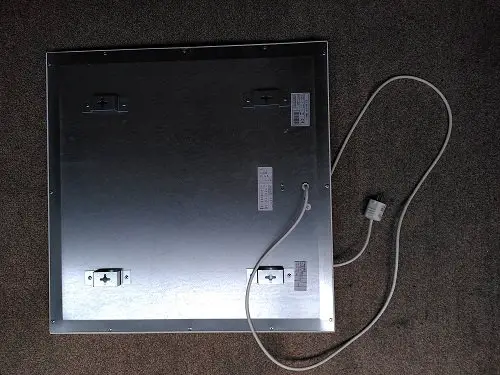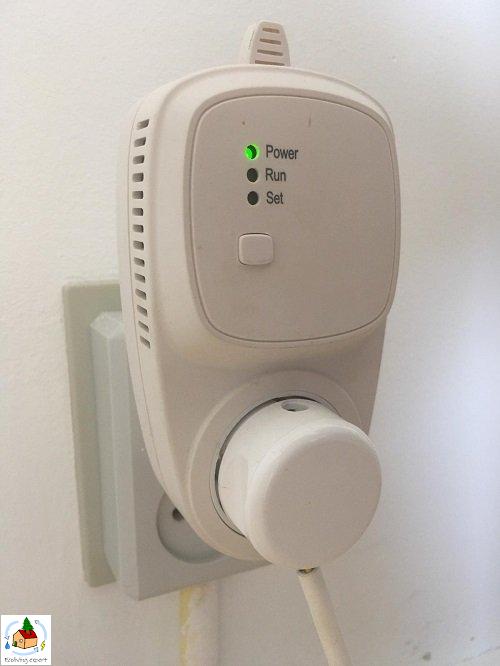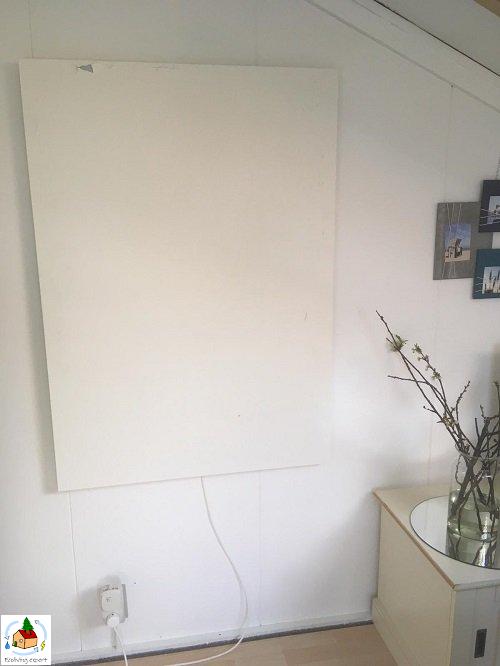Although infrared heating panels provide many benefits, there are some disadvantages to them. This article covers all the disadvantages of using infrared heating panels, and, when possible, covers how to deal with these potential issues.
The disadvantages of infrared panels are:
- No control options
- They don’t heat the air, and
- Don’t dry the air
- They require unobstructed space, and
- Run on expensive electricity
- Infrared heating health risks
No controls options
Most infrared heating panels have no display, buttons, or switches. They do not even have a power button.
The only option you have is whether to plug in the power cord or not. When plugged in, the panel will heat in under a minute and start emitting warming infrared equal to its power usage. If the panel is not plugged in, no heating is provided.
This means you do not have the option to lower the amount of heating the panels provide. They are either running at full capacity, or they are not plugged in.

How to overcome this potential issue
There are two options to overcome not having control options:
- be able to turn separate panels on and off easily. This can be done by installing a power/’light’ switch at the socket for every panel, or
- installing a thermostat that controls whether the panels get electricity or not
Thermostat
Using a thermostat is the easiest option. You will have to set a desired room temperature and allow it to control whether the panels get power or not. In this way, the panels are turned on and off by the thermostat according to the heating required to maintain the set temperature.
A friend of mine lived in a house that was entirely heated by infrared heating panels. They were controlled with a thermostat, which worked perfectly well. You can read more about her experience in my article here.

Install an infrared ‘light’ switch
At every socket or other power connection of each panel, you can install a switch similar to a light switch. This can control whether the panel is powered or not. Just as an actual light switch functions. In this way, you can easily turn the panels on or off depending on your heating requirements.
This works best when you have multiple panels. In this way, you have control over the total wattage of heat provided by the panels. For example, being able to turn off each of 5 panels of the same wattage individually works similarly to using one heating system with 5 heating modes.

As more and more infrared panels become available, some new models do have control options. I just bought a new 500-watt infrared heating panel that has an on/off switch, a function to set a timer, and the option for eco mode. this panel can also be remotely controlled by an app.
Infrared heaters do not heat the air
Most of us use traditional warm-air heating. This can be a CV, fireplace, or something similar. Each of these heating systems heats the air. This results in comfortable room temperatures, and in turn, makes us feel warm.
Infrared heating panels (and other infrared-based heaters) do not heat the air. They provide heating similar to the sun. Both the sun and infrared heaters produce infrared radiation. This heats objects and people that are in range of the heating rays. Just like when you feel the sunshine outside, but only when you step out of the shade.
Of course, eventually, the room’s air temperature will increase as people and objects in the room start to warm the air as they lose heat to their surroundings. However, they are heated first, and the air second. This is generally an advantage of infrared but can take some getting used to.
Infrared heating panels do not dry the air
Normal space heaters create warm air. Increasing the temperature of the air makes it dryer since the relative humidity will go down as a result. Infrared heaters do not produce warm air, they produce warm infrared rays just like the sun. This heats objects and people, but not the air.
Not heating the air means when the air is too humid, it stays that way. Normally, indoor heating also lowers the humidity to comfortable levels (around 50% relative humidity). If you have issues with high levels of humidity, infrared heating panels won’t help solve this.
I live in an area very close to a large body of water. On top of that, our climate in the Netherlands means the air is normally very humid. Both situations combined mean that the relative humidity is often much higher than what is comfortable and healthy.
With conventional air-heating systems, the indoor air would be dried, resulting in optimal levels of humidity. However, since we are currently heating with infrared panels, the air remains humid. Admittedly, this is a big disadvantage for us. We solved this by using supplemental warm-air heating or using a dehumidifier.
So, it could happen that switching to infrared heating panels will result in higher levels of humidity. This can be a benefit if you suffer from dry air. Otherwise, you might want to consider supplementing with warm-air heating or using a dehumidifier.
For more information on why infrared heaters do not heat the air, I recommend reading my article: This is why infrared heaters don’t dry the air.
Infrared panels require unobstructed space
The main disadvantage of heating with infrared radiation is that it is possible to be ‘in the shade’. For example, when someone stands in front of an infrared panel, they block the rays from reaching anything else. Also, objects can easily block the rays.
Therefore, infrared panels need some space around them to disperse their heat. The best and most common solution is to hang the panels on the ceiling. In this way, they can distribute their warmth equally around the room. They work similarly to the sun this way as they provide warming infrared rays from above.

They run on electricity, which is expensive
Infrared panels run on electricity. In terms of safety and sustainability, this is an advantage. However, electricity is the most expensive form of energy available.
Infrared is about 40% more efficient than other forms of heating (due to heating us directly and not having heat loss because of drafts). However, it is still likely going to increase your energy bill as the improved efficiency cannot yet compensate for the difference in price between electricity and gas.
For more information about the running costs of infrared heating panels, I recommend reading my article: The real running costs of infrared heating.
Infrared heating health risks
Many people are concerned about potential health risks related to infrared heating. This is understandable since infrared is a type of radiation and the word radiation gives people pause. Infrared heating is often compared to sunlight, and sunlight can cause sunburn and eventually skin cancer.
Luckily, many forms of radiation are not harmful and some are even beneficial to our health. Infrared heaters only emit far infrared radiation. This is a form of radiation that is experienced as heat and cannot cause any harm.
Because the sun emits many types of radiation, some of which are harmful to us such as UV, the comparison to sunlight makes us think that infrared heating might be harmful. This is not the case. Infrared heaters only emit healthful warming rays.
For more in-depth information and the answer to common health questions such as if infrared is harmful to our eyes, I recommend reading my article: Infrared heater dangers: 5 effects you need to know.


